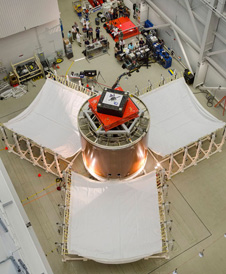NASA is carrying out a series of tests to ensure the agency’s Orion spacecraft can successfully jettison its protective fairings, or covers, during its ride to space. During the first of these tests, two of the three fairing panels separated as planned, but a third didn’t.
The fairings are panels that will protect Orion’s service module from the environment around it, whether it’s heat, wind or acoustics. The testing is designed to demonstrate the fairing system’s separation sequence before Orion launches on its first mission, Exploration Flight Test-1 (EFT-1), which remains on track for September 2014. During the flight test, Orion will travel 3,600 miles into space and return to Earth for a landing in the Pacific Ocean. It will allow engineers on the ground to evaluate Orion’s design before humans take their first flight on it.
During the test, all pyrotechnic mechanisms and bolts separated as planned but the third fairing panel did not completely detach. Initial observations point to a potential contact interference. Engineers continue to evaluate the test data which will be compared with engineering models of the jettison to validate engineers’ expectations and, if necessary, improve the fairings’ design before the flight test.
“Developing a spacecraft capable of carrying humans to destinations in deep space is no easy task,” said Dan Dumbacher, deputy associate administrator for exploration systems development. “We are testing Orion in a variety of ways so we can improve our understanding of how the spacecraft will perform in space. Even though this test was not flawless, the data we obtained will be tremendously helpful going forward.”
Lockheed Martin, the primary contractor for Orion, conducted the test Monday at the company’s Sunnyvale, Calif., facility.
“This was a challenging system to design and test,” said Mark Geyer, Orion Program manager. “Completing this test helps us evaluate our design and assure mission safety and success.”
The three fairing panels, each 14 feet high and 13 feet wide, will surround and protect the service module during the ascent. Unlike conventional rocket fairings, Orion’s are designed to support half of the weight of the crew module and launch abort system during launch and ascent, which will maximize the size and capability of the spacecraft that can be delivered to orbit.
When the rocket carrying Orion has reached an altitude about 560,000 feet above Earth’s surface, the three fairing panels will jettison, or separate, leaving Orion attached to the rocket and exposed to space. Six frangible, or breakable, joints and six separation bolts are used to connect the fairing panels to the rocket and each other. In a carefully timed sequence, the joints will be fired apart, followed shortly by the bolts. Once all of the pyrotechnics have detonated, six spring assemblies will push the three panels away leaving the service and crew module to travel onward.
This first test focused on the normal mechanical loads expected to affect the fairing system during EFT-1. A test stand was built to simulate Orion’s service module, and three model panels were attached to it with 30,000 pounds added to mimic the weight of the spacecraft and the stress launch will put on it.
A second test is set to take place later this summer and will add the expected thermal loads to the mix by heating one panel to 200 degrees Fahrenheit. This will cause it to expand and could change its performance. The final test will be performed next year.
3 min read































